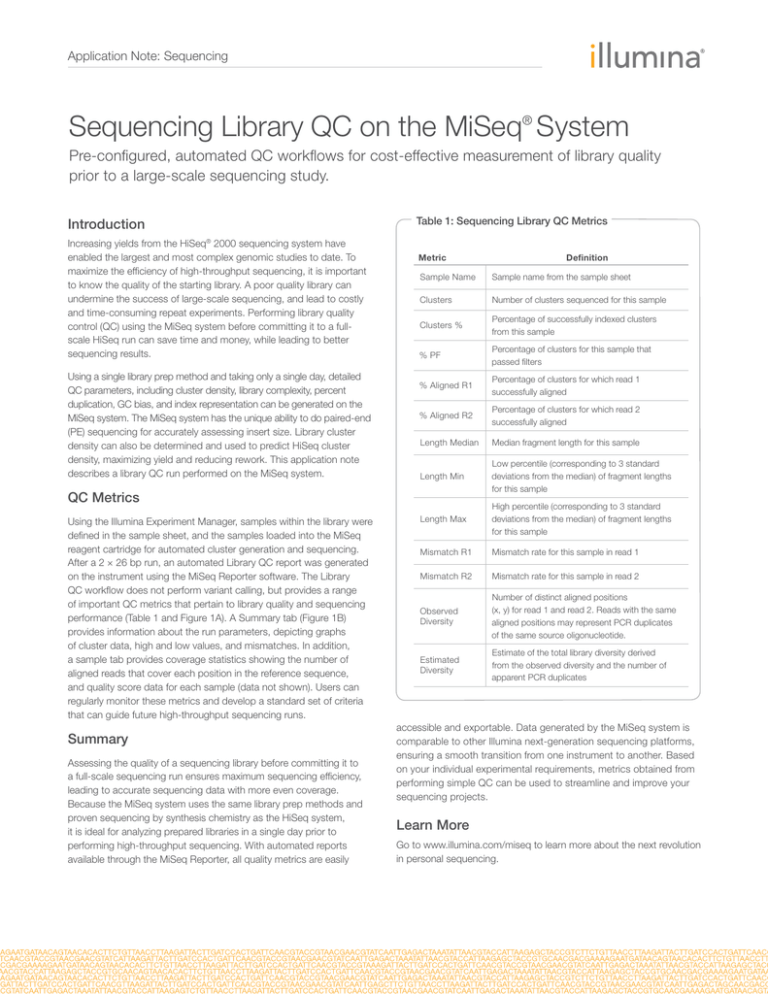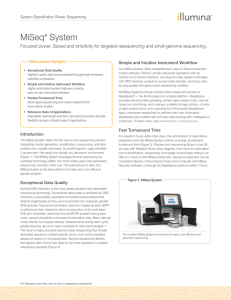
Application Note: Sequencing
Sequencing Library QC on the MiSeq® System
Pre-configured, automated QC workflows for cost-effective measurement of library quality
prior to a large-scale sequencing study.
Introduction
Increasing yields from the HiSeq® 2000 sequencing system have
enabled the largest and most complex genomic studies to date. To
maximize the efficiency of high-throughput sequencing, it is important
to know the quality of the starting library. A poor quality library can
undermine the success of large-scale sequencing, and lead to costly
and time-consuming repeat experiments. Performing library quality
control (QC) using the MiSeq system before committing it to a fullscale HiSeq run can save time and money, while leading to better
sequencing results.
Using a single library prep method and taking only a single day, detailed
QC parameters, including cluster density, library complexity, percent
duplication, GC bias, and index representation can be generated on the
MiSeq system. The MiSeq system has the unique ability to do paired-end
(PE) sequencing for accurately assessing insert size. Library cluster
density can also be determined and used to predict HiSeq cluster
density, maximizing yield and reducing rework. This application note
describes a library QC run performed on the MiSeq system.
Table 1: Sequencing Library QC Metrics
Metric
Sample name from the sample sheet
Clusters
Number of clusters sequenced for this sample
Clusters %
Percentage of successfully indexed clusters
from this sample
% PF
Percentage of clusters for this sample that
passed filters
% Aligned R1
Percentage of clusters for which read 1
successfully aligned
% Aligned R2
Percentage of clusters for which read 2
successfully aligned
Length Median
Median fragment length for this sample
Length Min
Low percentile (corresponding to 3 standard
deviations from the median) of fragment lengths
for this sample
Length Max
High percentile (corresponding to 3 standard
deviations from the median) of fragment lengths
for this sample
Mismatch R1
Mismatch rate for this sample in read 1
Mismatch R2
Mismatch rate for this sample in read 2
Observed
Diversity
Number of distinct aligned positions
(x, y) for read 1 and read 2. Reads with the same
aligned positions may represent PCR duplicates
of the same source oligonucleotide.
Estimated
Diversity
Estimate of the total library diversity derived
from the observed diversity and the number of
apparent PCR duplicates
QC Metrics
Using the Illumina Experiment Manager, samples within the library were
defined in the sample sheet, and the samples loaded into the MiSeq
reagent cartridge for automated cluster generation and sequencing.
After a 2 × 26 bp run, an automated Library QC report was generated
on the instrument using the MiSeq Reporter software. The Library
QC workflow does not perform variant calling, but provides a range
of important QC metrics that pertain to library quality and sequencing
performance (Table 1 and Figure 1A). A Summary tab (Figure 1B)
provides information about the run parameters, depicting graphs
of cluster data, high and low values, and mismatches. In addition,
a sample tab provides coverage statistics showing the number of
aligned reads that cover each position in the reference sequence,
and quality score data for each sample (data not shown). Users can
regularly monitor these metrics and develop a standard set of criteria
that can guide future high-throughput sequencing runs.
Summary
Assessing the quality of a sequencing library before committing it to
a full-scale sequencing run ensures maximum sequencing efficiency,
leading to accurate sequencing data with more even coverage.
Because the MiSeq system uses the same library prep methods and
proven sequencing by synthesis chemistry as the HiSeq system,
it is ideal for analyzing prepared libraries in a single day prior to
performing high-throughput sequencing. With automated reports
available through the MiSeq Reporter, all quality metrics are easily
Definition
Sample Name
accessible and exportable. Data generated by the MiSeq system is
comparable to other Illumina next-generation sequencing platforms,
ensuring a smooth transition from one instrument to another. Based
on your individual experimental requirements, metrics obtained from
performing simple QC can be used to streamline and improve your
sequencing projects.
Learn More
Go to www.illumina.com/miseq to learn more about the next revolution
in personal sequencing.
Application Note: Sequencing
Figure 1: Automated Library QC Reports Generated on MiSeq Reporter
A. Quality Control (QC) Tab showing quality metrics for the sequencing library, including sample name (column one), abundance (columns two through six),
fragment length (columns seven through nine), mismatch rate (columns ten through twelve), and library diversity (last two columns).
B. Summary Tab showing high-level run information including low run statistics (upper left graph), cluster performance (upper right),
high run statistics (lower left), and mismatches between reads and the reference sequence (lower right).
Illumina • 1.800.809.4566 toll-free (U.S.) • +1.858.202.4566 tel • techsupport@illumina.com • www.illumina.com
FOR RESEARCH USE ONLY
© 2011-2012, 2014 Illumina, Inc. All rights reserved.
Illumina, illuminaDx, BaseSpace, BeadArray, BeadXpress, cBot, CSPro, DASL, DesignStudio, Eco, GAIIx, Genetic Energy,
Genome Analyzer, GenomeStudio, GoldenGate, HiScan, HiSeq, Infinium, iSelect, MiSeq, Nextera, Sentrix, SeqMonitor, Solexa,
TruSeq, VeraCode, the pumpkin orange color, and the Genetic Energy streaming bases design are trademarks or registered
trademarks of Illumina, Inc. All other brands and names contained herein are the property of their respective owners.
Pub. No. 770-2011-014 Current as of 10 November 2014




